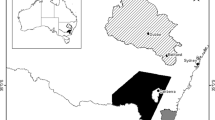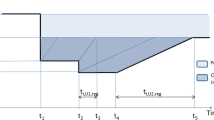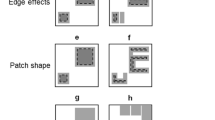Abstract
Goal, Scope and Background
Land use is an economic activity that generates large benefits for human society. One side effect, however, is that it has caused many environmental problems throughout history and still does today. Biodiversity, in particular, has been negatively influenced by intensive agriculture, forestry and the increase in urban areas and infrastructure. Integrated assessment such as Life Cycle Assessment (LCA), thus, incorporate impacts on biodiversity. The main objective of this paper is to develop generic characterization factors for land use types using empirical information on species diversity from Central Europe, which can be used in the assessment method developed in the first part of this series of paper.
Methods
Based on an extensive meta-analysis, with information about species diversity on 5581 sample plots, we calculated characterization factors for 53 land use types and six intensity classes. The typology is based on the CORINE Plus classification. We took information on the standardized α-diversity of plants, moss and mollusks into account. In addition, threatened plants were considered. Linear and nonlinear models were used for the calculation of damage potentials (EDP S). In our approach, we use the current mean species number in the region as a reference, because this determines whether specific land use types hold more or less species diversity per area. The damage potential calculated here is endpoint oriented. The corresponding characterization factors EDP S can be used in the Life Cycle Impact Assessment as weighting factors for different types of land occupation and land use change as described in Part 1 of this paper series.
Results
The result from ranking the intensity classes based on the mean plant species number is as expected. High intensive forestry and agriculture exhibit the lowest species richness (5.7–5.8 plant species/m2), artificial surfaces, low intensity forestry and non-use have medium species richness (9.4–11.1 plant species/m2) and low-intensity agriculture has the highest species richness (16.6 plant species/m2). The mean and median are very close, indicating that the skewedness of the distribution is low. Standard error is low and is similar for all intensity classes. Linear transformations of the relative species numbers are linearly transformed into ecosystem damage potentials (EDP S linear ). The integration of threatened plant species diversity into a more differentiated damage function \(EDP_{linear}^{S_{total} } \) makes it possible to differentiate between land use types that have similar total species numbers, but intensities of land use that are clearly different (e.g., artificial meadow and broad-leafed forest). Negative impact values indicate that land use types hold more species per m2 than the reference does. In terms of species diversity, these land use types are superior (e.g. near-to-nature meadow, hedgerows, agricultural fallow).
Discussion
Land use has severe impacts on the environment. The ecosystem damage potential EDP S is based on assessment of impacts of land use on species diversity. We clearly base EDP S factors on α-diversity, which correlates with the local aspect of species diversity of land use types. Based on an extensive meta-analysis of biologists’ field research, we were able to include data on the diversity of plant species, threatened plant species, moss and mollusks in the EDP S. The integration of other animal species groups (e.g. insects, birds, mammals, amphibians) with their specific habitat preferences could change the characterization factors values specific for each land use type. Those mobile species groups support ecosystem functions, because they provide functional links between habitats in the landscape.
Conclusions
The use of generic characterization factors in Life Cycle Impact Assessment of land use, which we have developed, can improve the basis for decision-making in industry and other organizations. It can best be applied for marginal land use decisions. However, if the goal and scope of an LCA requires it this generic assessment can be complemented with a site-dependent assessment.
Recommendations and Perspectives
We recommend utilizing the developed characterization factors for land use in Central Europe and as a reference methodology for other regions. In order to assess the impacts of land use in other regions it would be necessary to sample empirical data on species diversity and to develop region specific characterization factors on a worldwide basis in LCA. This is because species diversity and the impact of land use on it can very much differ from region to region.
Similar content being viewed by others
References
Adam M (1995): Die Übergangszone von Buchen-und Fichtenwald in den nördlichen Kalkalpen — Klimatische, edaphische und vegetationskundliche Aspekte: Dargestellt am Beispiel des Tamina-und Calfeisentales (SG/GR). Cramer, Berlin
Alard D, Podevigne I (2000): Diversity patterns in grassland along a landscape gradient in northwestern France. Journal of Vegetation Science 11, 287–294
Albracht R (1997): Zur Variabilität des Arteninventares verschiedener Bereiche von Fussballrasen, Golfplätzen und Mähweiden. Fachbereich Agrarwissenschaften und Umweltsicherung. University Gießen, Gießen
Archibald EEA (1949): The species character of plant communities. II. A quantitative approach. Journal of Ecology 37, 260–274
Arrhenius O (1921): Species and area. Journal of Ecology 9, 95–99
Balvanera P, Lott E, Segura G, Siebe C, Islas A (2002): Patterns of bdiversity in a Mexican tropical dry forest. Journal of Vegetation Science 13, 145–158
Barthlott W (1998): The uneven distribution of global biodiversity: A challenge for industrial and developing countries. In: Ehlers E, Krafft T (eds), German Global Change Research 1998. German National Committee on Global Change Research, Bonn, 36 pp
Barthlott W, Biedinger N, Braun G, Feig F, Kier G, Mutke J (1999): Terminological and methodological aspects of the mapping and analysis of the global biodiversity. Acta Botica Fennica 162, 103–110
BDM (2004): Biodiversity Monitoring Switzerland. Indicator Z9: Species Diversity in Habitats 〈www.biodiversitymonitoring.ch〉. BUWAL (Bundesamt für Umwelt, Wald und Landschaft), Bern
Bigler F, Jeanneret P, Lips A, Schüpbach B, Waldburger M, Fried P (1998): Wirkungskontrolle der Öko-Massnahmen: Biologische Vielfalt. Agrarforschung 5, 379–382
Bruelheide H (1995): Die Grünlandgesellschaften des Harzes und ihre Standortbedingungen. Mit einem Beitrag zum Gliederungsprinzip auf der Basis von statistisch ermittelten Artengruppen. Cramer, Berlin, Stuttgart
BUWAL (2002): Rote Liste der gefährdeten Farn-und Blütenpflanzen der Schweiz. BUWAL (Swiss Agency for the Environment, Forests and Landscape), Bern
Callauch R (1981): Ackerunkraut-Gesellschaften auf biologischen und konventionellen Äckern in der weiteren Umgebung von Göttingen. Tuexenia. Mitteilungen der Floristisch-soziologischen Arbeitsgemeinschaft 1, 25–37
Cowell S (1998): Environmental Life Cycle Assessment of Agricultural Systems: Integration into Decision-Making. Centre of Environmental Strategy. University Surrey, Surrey
Daily GC (ed) (1997): Nature’s Services. Societal Dependence on Natural Ecosystems. Island Press, Washington, DC, Covelo, California
Döring-Mederake U (1991): Feuchtwälder im nordwestdeutschen Tiefland. Gliederung — Ökologie — Schutz. Erich Goltze, Göttingen
Duelli P, Obrist MK (1998): In search of the best correlates for local organismal biodiversity in cultivated areas. Biodiversity and Conservation 7, 297–309
Ehrlich PR, Ehrlich AH (1981): Extinction. The causes and consequences of the disappearance of species. Random House, New York
European Environmental Agency (2000): CORINE Land Cover. European Environmental Agency, Luxembourg
Ewald J (1997): Die Bergmischwälder der Bayerischen Alpen: Soziologie, Standortbindung und Verbreitung. Cramer, Berlin
Fahrig L, Jonsen I (1998): Effect of habitat patch characteristics on abundance and diversity of insects in an agricultural landscape. Ecosystems 1, 197–205
Flückiger PE (1999): Der Beitrag von Waldrandstrukturen zur regionalen Biodiversität. Dissertation, University Basel, Olten
Giegrich J, Sturm K (1996): Operationalisierung der Wirkungskategorie Naturraumbeanspruchung. Institut für Energie und Umwelt (IFEU), Heidelberg
Gleason HA (1922): On the relation between species and area. Ecology 3, 158–162
Gleason HA (1925): Species and area. Ecology 6, 66–74
Goedkoop M, Hofstetter P, Müller-Wenk R, Spriensma R (1998): The Eco-Indicator 98 explained. Int J LCA 3, 352–360
Goedkoop M, Spriensma R (1999): The Eco-Indicator 99. A Damage Oriented Method for Life Cycle Impact Assessment. Methodology Report. Ministerie van Volkshuisvesting, Den Haag
Grüttner A (1990): Die Pflanzengesellschaften und Vegetationskomplexe der Moore des westlichen Bodenseegebietes. Cramer, Berlin, Stuttgart
He F, Legendre P (1996): On species-area relations. American Naturalist 148, 719–737
Heck KL, van Belle G, Simberloff D (1975): Explicit calculation of the rarefaction diversity measurement and the determination of sufficient sample size. Ecology 56, 1459–1461
Hector A, Schmid B, Beierkuhnlein C, Caldeira MC, Diemer M, Dimitrakopoulos PG, Finn JA, Freitas H, Giller PS, Good J, Harris R, Högberg P, Huss-Danell K, Joshi J, Jumpponen A, Körner C, Leadley PW, Loreau M, Minns A, Mulder CPH, O’Donovan G, Otway SJ, Pereira JS, Prinz A, Read DJ, Scherer-Lorenzen M, Schulze E-D, Siamantziouras D, Spehn EM, Terry AC, Troumbis AJ, Woodward FI, Yachi S, Lawton HJ (1999): Plant diversity and productivity experiments in European grasslands. Science 286, 1123–1127
Heijungs R, Guinée J, Huppes G (1997): Impact Categories for Natural Resources and Land Use. Centre of Environmental Science (CML), Leiden
Hurlbert SH (1971): The nonconcept of species diversity: A critique and alternative parameters. Ecology 52, 577–586
IUCN (2001): IUCN Red List. Categories and Criteria. Version 3.1. IUCN Species Survival Commission, Gland, Switzerland and Cambridge, UK
Kisteneich S (1993): Die auenbegleitenden Schwarzerlen-und Stieleichen-Hainbuchenwälder des Bergischen Landes. Cramer, Berlin
Koellner T (2000): Species-pool effect potentials (SPEP) as a yardstick to evaluate land use impacts on biodiversity. J Cl Prod 8, 293–311
Koellner T (2003): Land Use in Product Life Cycles and Ecosystem Quality. Peter Lang, Bern, Frankfurt a. M., New York
Koellner T, Hersperger A, Wohlgemuth T (2004): Rarefaction method for assessing plant species diversity on a regional scale. Ecography 27, 532–544
Koellner T, Scholz RW (2007): Assessment of land use impacts on the natural environment. Part 1: An analytical framework for pure land occupation and land use change. Int J LCA 12(1) 16–23
Lawton JH (1996): The role of species in ecosystems: aspects of ecological complexity and biological diversity. In: Abe T, Levin SA, Higashi M (eds), Biodiversity. An ecological perspective. Springer, New York
Levin SA (2000): Multiple scales and the maintenance of biodiversity. Ecosystems 3, 498–506
Lindeijer E, van Kampen M, Fraanje P, van Dobben H, Nabuurs GJ, Schouwenberg E, Prins D, Dankers N (1998): Biodiversity and Life Support Indicators for Land Use Impacts in LCA. IVAM ER, IBNDLO, Wageningen, Texel
Lindeijer E (2000): Biodiversity and life support impacts of land use in LCA. J Cl Prod 8, 313–319
Lips A, Dubois D et al. (1997): Belebte Umwelt. In: Wolfensberger U, Dinkel F (eds), Beurteilung nachwachsender Rohstoffe in der Schweiz in den Jahren 1993–1996. Vergleichende Betrachtung von Produkten aus ausgewählten NWR und entsprechenden konventionellen Produkten bezüglich ihrer Umweltwirkungen und Wirtschaftlichkeit. FAT Carbotech, Tänikon, Basel
Lundberg J, Moberg F (2003): Mobile link organisms and ecosystem functioning: Implications for ecosystem resilience and management. Ecosystems 6, 87–98
MacArthur RH (1965): Patterns of species diversity. Biol. Rev. 40, 510–533
Magurran AE (1996): Ecological Diversity and its Measurement. Chapman & Hall, London
Manz E (1997): Vegetation ehemals militärisch genutzter Übungsplätze und Flugplätze und deren Bedeutung für den Naturschutz. Tuexenia 17, 173–192
Milà i Canals L, Bauer C, Depestele J, Dubreuil A, Freiermuth Knuchel R, Gaillard G, Michelsen O, Müller-Wenk R, Rydgren B (2007): Key elements in a framework for land use impact assessment within LCA. Int J LCA 12(1) 5–15
Müller-Wenk R (1998): Land Use — The Main Threat to Species. How to Include Land Use in LCA. Institute for Economy and the Environment (IWÖ), University St. Gallen, St. Gallen
Murmann-Kristen L (1987): Das Vegetationsmosaik im Nordschwarzwälder Waldgebiet. Cramer, Berlin
Naeem S, Li S (1997): Biodiversity enhances ecosystem reliability. Nature 390, 507–509
Palmer MW (1990): The estimation of species richness by extrapolation. Ecology 71, 1195–1198
Peterson G, Allen CR, Holling CS (1998): Ecological resilience, biodiversity, and scale. Ecosystems 1, 6–18
Reidl K (1989): Floristische und vegetationskundliche Untersuchungen als Grundlage für den Arten-und Biotopschutz in der Stadt — dargestellt am Beispiel Essen. GHS Essen, Essen
Ricotta C, Carranza ML, Avena G (2002): Computing β-diversity from species area curves. Basic and Applied Ecology 3, 15–18
Schenck R (2001): Land Use and Biodiversity Indicators for Life Cycle Impact Assessment. Int J LCA 6, 114–117
Schläpfer F, Schmid B (1999): Expert estimates about effects of biodiversity on ecosystems processes and services. OIKOS 84, 346–352
Schreiber C (1995): Vergleich der Artenvielfalt von konventionellen-, IP-und Biobetrieben (auf verschiedenen Unterlagen in der kollinensubmontanen Stufe) im westlichen Aargauer Mittelland. Geobotanisches Institut und Institut für Agrarwirtschaft. ETH Zürich, Zürich
Schulte W (1985): Florenanalyse und Raumbewertung im Bochumer Stadtbereich. Geographisches Institut der Ruhr-Universität Bochum, Bochum
Schulze ED, Mooney HA (1994): Ecosystem function of biodiversity. A summary. In: Schulze ED, Mooney HA (eds), Biodiversity and ecosystem function. Springer, Berlin, New York, 525 pp
Shannon C (1948): A mathematical theory of communication. Bell Systems Technical Journal 27, 379–423
Simberloff DS (1978): Use of rarefaction and related methods in ecology. Pages 150–165 in Dickson J Cairns KL, Jr., Livingston RJ, eds. Biological Data in Water Pollution Assessment: Quantitative and Statistical Analysis. American Society for Testing and Materials, Philadelphia
Simpson EH (1949): Measurement of diversity. Nature 163, 688
Sukopp H (ed) (1990): Stadtökologie. Das Beispiel Berlin. Dietrich Reimer, Berlin
Udo de Haes H, Jolliet O, Finnveden G, Hausschild M, Krewitt W, Müller-Wenk R (1999): Best available practice regarding impact categories and category indicators in Life Cycle Impact Assessment. Background document for the second working group on Life Cycle Impact Assessment of SETAC-Europe (WIA-2) Part A. Int J LCA 4, 66–74
Udo de Haes HA. (2006): How to approach land use in LCIA or, how to avoid the Cinderella effect? Comments on ‘Key Elements in a Framework for Land Use Impact Assessment Within LCA’. Int J LCA 11, 219–221
UNEP (1992): Convention on Biological Diversity. United Nations Environment Programme (UNEP), Nairobi, Kenya
Vogtländer JG, Lindeijer E, Witte J-PM, Hendriks C (2004): Characterizing the change of land use based on flora: Application for EIA and LCA. J Cl Prod 12, 47–57
von Oheimb G (2003): Einfluss forstlicher Nutzung auf die Artenvielfalt und Artenzusammensetzung der Gefässpflanzen in norddeutschen Laubwäldern. Kovac, Hamburg
Werner F, Scholz RW. (2002): Ambiguities in decision-oriented life cycle inventories. The role of mental models. Int J LCA 7, 330–338
Whittaker RH (1972): Evolution and measurement of species diversity. Taxon 21, 213–251
Whittaker RJ, Willis KJ, Field R (2001): Scale and species richness: towards a general, hierarchical theory of species diversity. Journal of Biogeography 28, 453–470
Wiertz van Dijk J, Latour JB (1992): MOVE: Vegetatie-module; de kans op voorlomen van 700 plantsoorten als functie van vocht, pH, nutienten en zout. RIVM, Bilthoven
Wittwer A, Meier R, Bolliger P, Wittwer J, Thomet P, Thomet E, Beyeler H (1997): Ökologischer Ausgleich. Erste Erfolgskontrollen in drei Regionen aus der Sicht der Förderung der Artenvielfalt. Bundesamt für Umwelt, Wald und Landschaft (BUWAL), Bern
Wohlgemuth T (1992): Die vegetationskundliche Datenbank. Schweiz Z Forstwes 143, 22–36
Wohlgemuth T (1998): Modelling floristic species richness on a regional scale: A case study in Switzerland. Biodiversity and Conservation 7, 159–177
WSL/FNP. (without year): EDV-Flora der Schweiz 1.0. Eidgenössische Forschungsanstalt für Wald, Schnee und Landschaft (WSL/FNP), Birmensdorf
Zerbe S (1999): Die Wald-und Forstgesellschaften des Spessarts mit Vorschlägen zu deren zukünftigen Entwicklung, Aschaffenburg
Author information
Authors and Affiliations
Corresponding author
Electronic supplementary material
Rights and permissions
About this article
Cite this article
Koellner, T., Scholz, R.W. Assessment of land use impacts on the natural environment. Int J Life Cycle Assess 13, 32–48 (2008). https://doi.org/10.1065/lca2006.12.292.2
Received:
Accepted:
Published:
Issue Date:
DOI: https://doi.org/10.1065/lca2006.12.292.2




